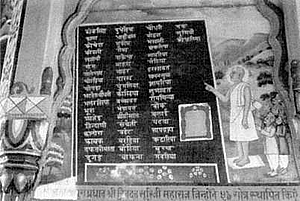Because of its putative time-depth, the Osiya legend might be considered the most "inclusive" account of Osval origin. From the perspective of Jaipur, however, the Osiya myth seems to recede into a nebulous background. In this city, the dominant influence is the Khartar Gacch, and the most relevant Osval origin mythology emphasizes the role of this mendicant lineage in the creation of Osval clans. I will refer to this body of material as the Khartar Gacch legends. Because the Khartar Gacch did not come into existence until the eleventh century C.E., the putative time frame of the Khartar Gacch legends is much later than that of the Osiya legend.
Lest we lose the thread of our overall argument, it must be emphasized that the Khartar Gacch legends stress, as does the Osiya legend, the claim of Rajput/Ksatriya origin for most Osval clans. In a history of the Osval caste that adopts the Khartar Gacch perspective (Bhansali 1982; see chart on pp. 217-22), out of the eighty-one major clans listed, a total of sixty-five are (by my reckoning) traced to Rajput/Ksatriya clans or lineages.[1] Six are held to be of Mahesvari (a business caste similar to the Osvals) origin, but the Mahesvaris themselves are said to have been Ksatriyas originally. The remainder (including two clans of Brahman origin) can be regarded as special cases that do not disconfirm the main trend.
These accounts may be considered to be expressions of a coherent general theory about the origin of the community of Osval Jains. This is a theory that was shared by most of those with whom I discussed these matters in Jaipur. Some were hazy about the specifics, but the general view that Osval clans were created when Rajputs were converted to Jainism by distinguished ascetics - mostly Khartar Gacch ascetics - was quite widespread (see Figure 12 for an illustration of this belief). The Khartar Gacch legends themselves are less focused on the origin of the Osval caste as a whole than on the separate origins of Osval clans. As articulated to me by Jaipur respondents, the underlying theory holds that the Osval clans were created by Jain monks. These monks then encouraged their converts to marry only their co-religionists. In this way, the exogamous clans became knit into the encompassing Osval caste.
In what follows I draw heavily on two volumes that were placed in my hands by knowledgeable Jains in Jaipur. One is a history of the Osvals (cited above) authored by Sohanraj Bhansali (Bhansali 1982). The other is a short anthology of materials on jatis (castes) and clans putatively converted by Khartar Gacch monks (Nahta and Nahta 1978). Each of these books brings together large amounts of material gleaned from traditional genealogists, and together they are a rich source of material on Osval origins from the Khartar Gacch point of view.

Figure 12.
Jindattsuri pointing to the names of clans created by him. Picture
on the wall of the dadabari at Ajmer.
 Prof. Dr. Lawrence A. Babb
Prof. Dr. Lawrence A. Babb
